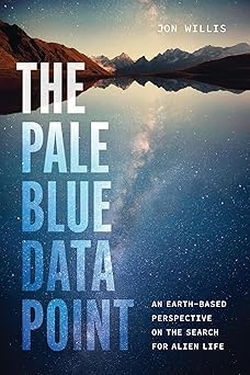Centauri Dreams
Imagining and Planning Interstellar Exploration
Musings on Fusion and the Interstellar Ramjet
Proton-proton fusion produces 99 percent of the Sun’s energy, in a process that begins with two hydrogen nuclei and ends with one helium nucleus, releasing energy along the way. We’d love to exploit the fusion process to create energy for our own directed uses, which is what Robert Bussard was thinking about with his interstellar ramjet when he published the idea in 1960. Such a ship might deploy electromagnetic fields thousands of kilometers in diameter to scoop up atoms from the interstellar medium, using them as reaction mass for the fusion that would drive it.

Carl Sagan was a great enthusiast for the concept, and would describe it vividly in the book he wrote with Russian astronomer and astrophysicist Iosif S. Shklovskii. In Intelligent Life in the Universe (1966), the authors discuss a journey that takes advantage of time dilation, allowing a lightspeed-hugging starship powered by these methods to reach galactic center in a mere 21 years of ship-time; i.e., time as perceived by the crew, while of course tens of thousands of years are going by back on Earth. If you also hear echoes of Poul Anderson’s Tau Zero here, you’re exactly on target.
Shklovskii and Sagan assume proton-proton fusion as the reaction, as Bussard originally did, but Thomas Heppenheimer was able to show in 1978 that it would take more power to compress the protons gathered from the interstellar medium than the reaction would produce. Ramscoops are tricky, and this is just one of their problems — gathering interstellar materials is another, dependent as it is on the density of the gases where the starship travels. Drag is yet another issue, making interstellar ramjets a segue into magsail deceleration rather than starship-enabling speed, though it’s a segue I’ll follow up on another occasion.
But the fusion itself is still interesting. If Bussard assumed proton-proton, it wouldn’t be long before Daniel Whitmire was able to show that a different reaction could produce far more power. The Carbon Nitrogen Oxygen cycle (CNO cycle) came to mind this morning because of word that the team working on the Borexino experiment in the Laboratori Nazionali del Gran Sasso (Italy), which studies the Sun’s fusion reactions through the neutrinos it produces, has been able to identify the CNO cycle as a small component of the Sun’s production of energy.

Image: The Borexino research team has succeeded in detecting neutrinos from the sun’s second fusion process, the Carbon Nitrogen Oxygen cycle (CNO cycle) for the first time. Credit: Borexino Collaboration.
That’s interesting in itself and confirms work by Hans Bethe and Carl Friedrich von Weizsäcker from the 1930s, the first experimental confirmation of their independent investigations. But I cycle back to Bussard’s ramjet. The Carbon Nitrogen Oxygen cycle involves four hydrogen nuclei combining to form a helium nucleus using carbon, nitrogen and oxygen as catalysts and intermediate products in the reaction. Maybe ‘catalysts’ isn’t the right word — I was reminded by reading Adam Crowl’s thoughts on the matter some years back that we’re not talking about chemical catalysis and should perhaps refer to all this simply as ‘nuclear chemistry.’
What boggles the mind about the CNO cycle, which I’ve read is the dominant energy source in stars more than 1.3 times more massive than the Sun, is the degree of energy unlocked by it, far exceeding uncatalyzed proton/proton fusion. And it would take something highly energetic to work on Bussard’s ramscoop, for Whitmire’s 1975 paper showed that a proton-proton reactor built in the fashion originally suggested by Bussard would need a scoop 7,000 kilometers across to make the reaction work.
Isn’t that odd? You would think that a reaction that powers the Sun would be perfectly sufficient to drive the Bussard ramjet, but it turns out that the rate of proton-proton fusion is too low. Looking back through my materials on the problem, I find that the Sun produces less than 1 watt per cubic meter when averaged over its whole volume, which means that the energy produced in a light bulb filament is more powerful. Whitmire realized that the Sun’s vast energy output could occur because of its size. Making equally massive starships is out of the question.
It turns out that Whitmire and Centauri Dreams regular Al Jackson were friends at the University of Texas back in the 1970s, and I’ll remind you of Al’s reminiscence of Whitmire that can be found here — it was actually Al who introduced the Bussard ramscoop idea to Whitmire. Bussard would write to Whitmire that his 1975 paper offered a solution to the proton-proton fusion problem and would “become an enduring classic in this field.”
If you know your science fiction, you’ll recall that Greg Benford uses the CNO cycle in his 1984 novel Across the Sea of Suns, where he gives a poetic description of the process at work as perceived by his protagonist via the ultimate in futuristic telepresence:
He watches plumes of carbon nuclei striking the swarms of protons, wedding them to form the heavier hydrogen nuclei. The torrent swirls and screams at Nigel’s skin and in his sensors he sees and feels and tastes the lumpy, sluggish nitrogen as it finds a fresh incoming proton and with the fleshy smack of fusion the two stick, they hold, they wobble like raindrops — falling together — merging — ballooning into a new nucleus, heavier still: oxygen.
But the green pinpoints of oxygen are unstable. These fragile forms split instantly. Jets of new particles spew through the surrounding glow — neutrinos, ruddy photons of light, and slower, darker, there come the heavy daughters of the marriage: a swollen, burnt-gold cloud. A wobbling, heavier isotope of nitrogen….
Ahead he sees the violet points of nitrogen and hears them crack into carbon plus an alpha particle. So in the end the long cascade gives forth the carbon that catalyzed it, carbon that will begin again its life in the whistling blizzard of protons coming in from the forward maw of the ship.
And there you are: Carbon – Nitrogen – Oxygen in a cycle that makes starship fusion work. And all of this reminiscing suggested by the results of an experiment deep below the the Italian Gran Sasso massif which has turned up evidence for the CNO cycle within the Sun, a small but ongoing component of its output. If you want to read more on what turned up at Borexino, the paper is The Borexino Collaboration, “Experimental evidence of neutrinos produced in the CNO fusion cycle in the Sun,” Nature 587 (2020), 577-582 (abstract). The Whitmire paper is “Relativistic Spaceflight and the Catalytic Nuclear Ramjet,” Acta Astronautica 2 (1975), pp. 497-509 (abstract).

A Centaur in Transformation
There was a time when the Solar System seemed relatively well defined, with nine planets including Pluto and an asteroid belt that orbited in a niche between Mars and Jupiter. These days, in addition to the Kuiper Belt and Oort Cloud, we have to factor in all the objects that move on unusual orbits. We have a mission in the works, called Lucy, to the Jupiter Trojans, those asteroids that share the giant planet’s orbit around the Sun. And today we’re looking at Centaurs, which cross the orbits of giant planets and are in rapid dynamical evolution.
The subject comes up because a newly discovered comet — 2019 LD2 (ATLAS) — is not only a Centaur, but a Centaur that is rapidly on its way to becoming another class of object, a Jupiter Family Comet (JFC). The latter are short-period comets with an orbital period of less than 20 years, largely under the influence of Jupiter. A paper by Jordan Steckloff (Planetary Science Institute) and team lays out the case: Centaurs are objects in transition.
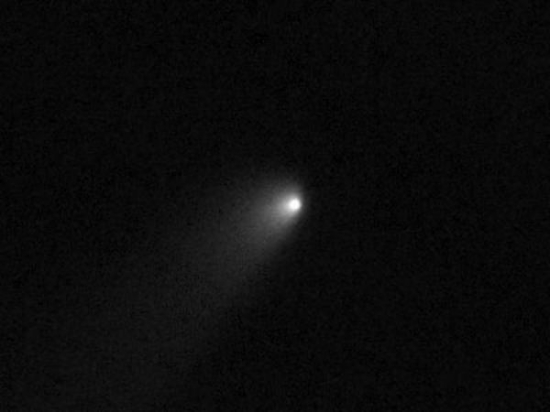
Image: Comet 2019 LD2 (ATLAS) as seen by the Hubble Space Telescope. Credit: Hubble Space Telescope/Bryce Bolin.
According to the paper, the new comet is in the earliest parts of a transition that is common to Centaurs. Their orbits, between Jupiter and Neptune, are unstable. Their fate takes them in one of two directions: They may be ejected from the Solar System entirely, or they may evolve into Jupiter Family Comets. They first emerge beyond the orbit of Neptune, putting them into the category of trans-Neptunian Objects, with gravitational interactions in the outer system pulling them into the population of Centaurs.
The transition to Jupiter Family Comet is, in astronomical terms, a fleeting affair, lasting from a few million to a few tens of millions of years, according to the researchers. And tracing their evolution produces what the authors refer to as a ‘gateway’ that helps them make the transition into JFC status. Thus Steckloff:
“We find that 2019 LD2 is currently in the vicinity of a dynamical ‘Gateway’ that facilitates the majority of transitions from the Centaur population into the Jupiter Family of Comets. The dynamical gateway is a region beyond Jupiter, extending to just inside of Saturn’s influence. Our previous work (Sarid et al. 2019) found that the majority of JFCs first pass through this dynamical gateway as Centaurs immediately prior to transitioning into the JFC population; indeed this ‘Gateway Region’ facilitates the majority of transitions between the JFC and Centaur populations. Currently, there are a handful of objects in the gateway, including LD2, and the much more famous object 29P/Schwassmann-Wachmann 1.”
Let’s pull up short for a moment with that last reference. 29P/Schwassmann-Wachmann 1, known since the 1920s, displays frequent outbursts that cause a sudden change in magnitude, brightening in some cases as much as a thousand times. The outbursts are sudden and tend to fade within days, evidently the result of cryovolcanic activity. Like 2019 LD2, 29P/Schwassmann-Wachmann 1 is a Centaur in transition into a Jupiter Family Comet.
The presence of super-volatile ices on 2019 LD2 points to the pristine nature of the object, which according to Steckloff is unlikely ever to have been in the inner Solar System. Here we are looking at a comet whose ices are subliming for the first time, driving cometary activity. The astronomer says this will be a rapid process: “…this transition is likely to finish in only 40 years from now, which is a blink of an eye for astronomy. This means that people alive today will be able to follow this object all the way through its transition into the JFC population.”
As part of that change in perspective that has taught us so much about the wide range of outer system objects, we’re learning that our definitions have to be malleable enough to incorporate objects that, on the range from active comets to inactive asteroids, can take on characteristics of either, presenting different aspects as they proceed through this dynamical evolution. Fast-changing 2019 LD2 is a chance to witness such change within our lifetimes.
The paper is Steckloff et al., “P/2019 LD2 (ATLAS): An Active Centaur in Imminent Transition to the Jupiter Family,” Astrophysical Journal Letters. Abstract.

Exoplanet Imaging via a Fast New Camera
The world’s largest superconducting camera by pixel count has been deployed at the Subaru Telescope at Mauna Kea in Hawaii. This is a technology we’ll want to watch, for it assists the effort to image exoplanets directly from the surface of the Earth, a goal that not so long ago would have seemed impossible. But it can be done, and we have a new generation of extremely large telescopes (ELTs) on the way, so the progress in support technology for such installations is heartening.
The new device is called the MKID Exoplanet Camera (MEC), with the four-letter acronym standing for Microwave Kinetic Inductance Detector. A superconducting photon detector was first developed as far back as 2003 at Caltech and the Jet Propulsion Laboratory, paving the way for devices that can operate at wavelengths ranging from the far-infrared to X-rays. The MEC comes out of the laboratory of Ben Mazin at the University of California at Santa Barbara as part of an effort that includes contributions from both US and Japanese scientists.
The MKID Exoplanet Camera operates in the optical and near infrared, running at 90 millikelvin, or 1/1000th of a Kelvin, which is close to absolute zero. The technology involved can read out data thousands of times per second, according to the MEC’s developers, which plays directly into the success of adaptive optics systems that are designed to correct for atmospheric distortions. Current adaptive optics methods bend a telescope’s mirror at a rate of thousands of times per second, using complex algorithms to produce an image as it if were taken in space.
The problem: Planets most likely to be found with today’s adaptive optics are young worlds still glowing with the heat of their formation. Mazin points to HR 8799, a system with four gas giants, each of which is more massive than Jupiter, as the kind of catch currently available, and indeed, HR 8799 has been confirmed by direct imaging with the Keck and Gemini telescopes in Hawaii. The planets are still hot and glowing as the system matures. Moving into the range of smaller, cooler worlds will take exquisite collaboration between adaptive optics and the camera.
The MKID technology allows Mazin’s MEC to determine the energy of each photon as it hits the detector. Sarah Steiger is a UC-Santa Barbara doctoral student who worked on the project:
“This allows us not only to determine a planet’s brightness, but also to get a spectrum (the brightness as a function of energy), which can reveal additional information about an exoplanet’s properties, such as its age, mass and potentially atmospheric composition.”

Image: The 20440 pixel MKID device designed for MKID Exoplanet Camera is the highest pixel-count superconducting detector array at any wavelength. Credit: UC-Santa Barbara.
The fast data rates available with an MKID mean that the technology can work interactively with an observatory’s adaptive optics system to remove scattered and diffracted starlight, which allows the detection of exoplanets much fainter than can currently be imaged. In terms of astrobiology, says Olivier Guyon, that means we can one day turn the MEC to nearby exoplanets that can be characterized in greater detail than before. Guyon is the project scientist in charge of the Subaru Coronagraphic Extreme Adaptive Optics (SCExAO) instrument:
“We’re not going to be able to do that with Subaru, or with any of the current telescopes, because they’re just a bit too small. But we’re preparing for the next big step, which is to deploy exoplanet imaging cameras on larger telescopes such as the Thirty Meter Telescope. When those telescopes come online, the same technologies, the same camera, the same tricks will allow us to actually look for life.”
Ahead for Mazin’s team is the refinement of the software and algorithms that make MEC effective, with fast optical correction being the focus for the next several years. For more on the camera and its ongoing development, see Walter et al., “The MKID Exoplanet Camera for Subaru SCExAO,” Publications of the Astronomical Society of the Pacific Vol. 132, No. 1018 (17 November 2020). Abstract.

Simultaneous Growth of Star and Planet?
The evolving system known as [BHB2007] 1 is a part of the Pipe Nebula (also called Barnard 59), about 600 light years away in the constellation Ophiuchus. It is part of a binary star system in formation that has been studied with the Atacama Large Millimeter Array (ALMA). Both protostars show disks in formation around them, surrounded by filaments of gas and dust drawn from the larger disk that are being referred to as ‘feeding filaments.’ Paola Caselli (Max Planck Institute for Extraterrestrial Physics, Germany), who made that reference in 2019, is co-author of new work on the stellar object, which gives us an unusual look at early system formation.

Image: This false-color image shows the filaments of accretion around the protostar [BHB2007] 1. The large structures are inflows of molecular gas (CO) nurturing the disk surrounding the protostar. The inset shows the dust emission from the disk, which is seen edge-on. The “holes” in the dust map represent an enormous ringed cavity seen sideways in the disk structure. Credit © MPE.
This is apparently a case of star and planet growing in tandem. The young stellar object [BHB2007] 1 is thought to be no older than 1 million years, with most of the surrounding envelope having dissipated and clear emission visible from the circumstellar disk. The authors note the clean, wide gap in the dust, adding that it is surprising for such a young system, for accretion from the molecular cloud seems to be continuing, as the filament activity makes clear.
Most circumstellar disks in this age range are fully formed as planet formation begins. Felipe Alves (MPE) is lead author on the paper, which has just appeared in Astrophysical Journal Letters:
“We were quite surprised to observe such prominent accretion filaments falling into the disk. The accretion filament activity demonstrates that the disk is still growing while simultaneously nurturing the protostar.”
Supplementing the ALMA data with observations at radio frequencies from the Very Large Array, the researchers make the case for a young giant planet or perhaps a brown dwarf present within a 70 AU cavity inside the disk, a zone filled with hot molecular gas. Planetary accretion of an object between 4 and 70 Jupiter masses would produce the disk gap.
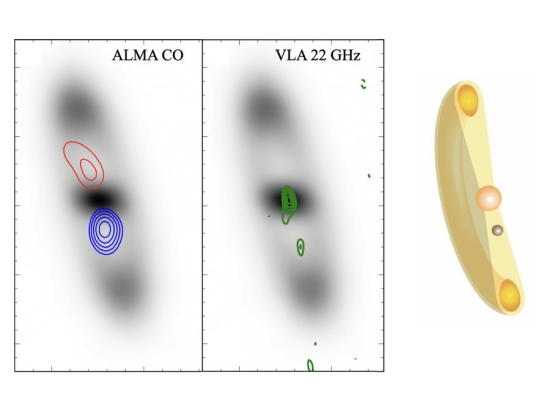
Image: Two different observations of the protoplanetary disk show signatures of the formation of a companion to the protostar . The grey scale represents the dust thermal emission from the disk, same as in the inset of Fig. 1. The red/blue contours show the molecular CO brightness emission levels from the northern/southern side of the dust cavity observed with ALMA. The brighter CO emission from the south indicates that the gas is hotter there. This location coincides with a zone of non-thermal emission tracing ionised gas (green contours) observed with the VLA (middle), which is observed in addition to the protostar (centre of the image). The team proposes that both the ionised gas and the hot molecular gas are due to the presence of a protoplanet or a brown dwarf in the cavity. The configuration of such a system is shown in the sketch on the right. Credit: © MPE; illustration: Gabriel A. P. Franco.
MPE’s Caselli explains the significance of the finding:
“We present a new case of star and planet formation happening in tandem. Our observations strongly indicate that protoplanetary disks keep accreting material also after planet formation has started. This is important because the fresh material falling onto the disk will affect both the chemical composition of the future planetary system and the dynamical evolution of the whole disk.”
Studying star and planet formation together gives us interesting constraints for how young systems evolve out of the original cloud surrounding them. [BHB2007] 1 gives us the kind of gap in a circumstellar disk we’ve observed in other young systems, but in this case it’s a disk still being actively fed by filaments from the surrounding molecular cloud. In at least one case, then, we see the possible formation of planets before the disk itself has fully formed. The existence of an object in formation is supported by VLA’s data on radio emission within the dust gap between the inner and outer disk, giving heft to the assertion that simultaneous formation is occurring.
The paper is Alves et al., “A case of simultaneous star and planet formation,” Astrophysical Journal Letters Vol. 904, No. 1 (19 November 2020). Abstract / Preprint.

Arecibo in Petition and Poetry
I’m tracking an online petition conceived by Jorge Santiago Ortiz that challenges the National Science Foundation: Repair the Arecibo Observatory, do not decommission it. Given Friday’s news of the planned shutdown due to problems with support cables and the dangers of possible repairs, it’s good to see an effort being made to explore the possible. Ortiz points out that the observatory employs more than 120 people, is visited by some 200 scientists every year working on research projects, and draws 100,000 visitors yearly from the general population.
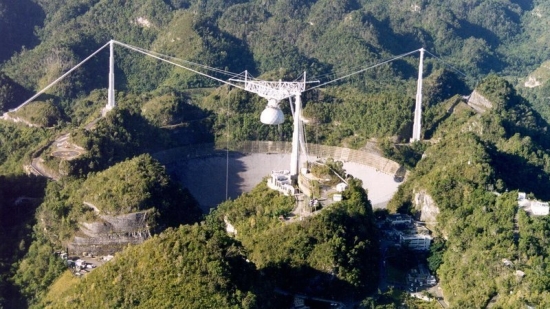
I notice the petition is approaching 6,000 signatures this morning as people react to the Arecibo news. It is possible there is a path toward keeping the observatory alive? Also noted by Centauri Dreams reader Jeff Brandt, himself a resident of Puerto Rico, is an attempt to free the facility from National Science Foundation funding and repair the structure.
Brandt notes that Jenniffer González-Colón, Puerto Rico’s representative in the US Congress, has sent a letter to the House & Senate Appropriations Committee requesting funding to stabilize the structure, as you can see below. We’ll keep an eye on both efforts.
Sent a letter w/ @RepStephMurphy & @RepDarrenSoto to the House & Senate Appropriations Committee requesting the necessary funds to safely stabilize the Arecibo telescope, a valuable scientific asset treasured by all Puerto Ricans & I'm committed to continuing work to preserve it. pic.twitter.com/pBwN3kumlw
— Jenniffer González (@RepJenniffer) November 20, 2020
It seems apropos in discussing Arecibo to give a nod to the Cornell connection, given the university’s involvement in its inception and subsequent management. The radio telescope was conceived by Cornell professor William E. Gordon, while its early scientific investigations were coordinated by Thomas Gold, who created the Cornell Center for Radiophysics and Space Research. Looking back, the university’s Jonathan Lunine comments on its significance:
“Arecibo has been an incredibly productive facility for nearly 60 years. For the Cornell scientists and engineers who took a daring dream and realized it, for the scientists who made new discoveries with this uniquely powerful radio telescope and planetary radar, and for all the young people who were inspired to become scientists by the sight of this enormous telescope in the middle of the island of Puerto Rico, Arecibo’s end is an inestimable loss.”
Thoughts Upon Hearing the Arecibo Radio Observatory was About to be Closed

Which brings me to Henry Cordova, who has graced these pages before with his SETI Reality Check, and who now looks back at a visit to Arecibo in the observatory’s early days in an essay that was written, I hasten to add, before the recent news of the site’s decommissioning. Trained as an astronomer and mathematician, Henry’s interest in the ways in which we observe the stars continues unabated. Arecibo clearly called out the poetry in him, as it did in me.
by Henry Cordova
I visited Arecibo Observatory in 1971, I was in Puerto Rico on business, and I took a Sunday off to visit the place. It’s a two hour drive from San Juan, and nestled in some pretty spectacular jungle-covered Karst topography: a very beautiful drive into an isolated and haunted countryside.
When I arrived the place was deserted. There was a small building, similar to a motel, where I supposed visiting researchers were quartered; but nobody was home. The permanent staff probably had houses in town (Arecibo proper is about a half-hour drive further north, on the coast). Next door, the control room was visible; through the locked glass doors I could see electronic equipment, powered up, but no one was there. Only my car was in the parking area. At the edge of the lot was a little observation platform where you could walk right up to the edge of the dish itself. It spread before me, filling a vast natural depression. The feeling was very much like standing at the edge of Meteor Crater in Arizona, except I could see suspended above me, on huge white towers, the receivers placed at the focus of the parabola.
The silence, the isolation, the grandeur of it all really affected me. The sheer audacity of the structure, the combination of natural beauty and technological brilliance was almost overpowering. I imagine it would be very similar to be standing alone at Stonehenge on a sunny windy day, accompanied only by ghosts.
Observatories are holy places. They are as impressive and beautiful as a medieval cathedral and by necessity are usually located in lonely and desolate landscapes. Like cathedrals, they are temples to the ineffable, to the incredibly remote, and to our faith in being able to connect with it–places of worship, in a way, sacred places. I know it’s sentimental and impractical of me, but if this site is to be abandoned, let it not be replaced with a farm or village or reservoir or some other practical symbol of the economy. Let it naturally decay into ruins, as a monument to our boldness, and to our stupidity. Centuries from now, men will stand in that place and say ‘we once explored the stars from here’.

On Losing Arecibo
I always wanted to get to Arecibo, the magnificent 305-meter telescope that has for so long been a locus for radio astronomy research, but I was never able to make it to Puerto Rico. Now I’ve run out of time. The National Science Foundation doesn’t make these decisions lightly but multiple engineering companies have delivered assessments that point to catastrophic failure of the telescope structure as a real possibility. Too dangerous to repair, and faced with stability issues even if it could be repaired, the Arecibo Observatory will be decommissioned.
The breakdown in the vast structure has been ongoing, bits and pieces of news that added further dismay to an already dismal 2020. A support cable detached in August, resulting in an evaluation from the University of Central Florida, which manages the site. Replacement auxiliary cables were then on the way, temporary cables available, but on November 6 another main cable broke. The stresses on the second cable evidently told the story, making it clear that to proceed with repair would be to push against acceptable standards of safety.
Ralph Gaume, director of NSF’s Division of Astronomical Sciences, sums up the situation:
“Leadership at Arecibo Observatory and UCF did a commendable job addressing this situation, acting quickly and pursuing every possible option to save this incredible instrument. Until these assessments came in, our question was not if the observatory should be repaired but how. But in the end, a preponderance of data showed that we simply could not do this safely. And that is a line we cannot cross.”

Image: Arecibo Observatory’s 305-meter telescope in November of 2020. Credit: University of Central Florida.
It’s going to take some time for me to get my head around losing Arecibo, which has been since the early 1960s a part of my mental landscape when contemplating our civilization and its context in the cosmos. I had gotten to thinking in terms of ‘Arecibos’ of transmitting power, meaning that a dish like Arecibo could pick up an installation of comparable power over a span of 1,000 light years, a volume in which there are more than 10,000,000 stars. Ideas like that fueled my interest in SETI, which grew into a general passion for exoplanet research.
Remember, although we sometimes hear 51 Pegasi b referred to as the first exoplanet discovered, the honor actually belongs to the planets at the pulsar PSR B1257+12, which were found three years earlier in 1992 by Aleksander Wolszczan and Dale Frail using Arecibo data (51 Pegasi b was the first exoplanet found around a main sequence star, a valid distinction since pulsar planets are an unusual extreme as we contemplate the conditions extant in planetary systems). Speaking of pulsars, the first binary one was uncovered in Arecibo data in 1974 by Russell Hulse and Joseph H. Taylor, Jr., a find that earned the duo the Nobel Prize for Physics in 1993.
Arecibo has produced radar maps of Venus and Mercury and has charted near-Earth asteroids. As far back as 1965, it uncovered the actual rotation rate of Mercury (59 days as opposed to the previously believed 88). It analyzed the pulsar from the Crab Nebula supernova remnant in 1968 and performed the first radar ranging to an Earth-crossing asteroid (1862 Apollo) in 1980. Its planetary radar found evidence for hydrocarbon lakes on Titan and the observatory was used to study frequencies in the 1,000 MHz to 3,000 MHz range as part of the SETI effort.
Indeed, the list of accomplishments is far too long to list here, so I’ll direct you to this summary page. I do want to mention in the SETI context (although it was a matter of transmitting rather than listening) the 1974 message sent toward the globular cluster M13 by Frank Drake, primarily performed, I’m told, as a way of demonstrating what newly installed equipment could do. Even so, that transmission is an oft-cited marker in our thinking about our own place in the universe and the possibility of other technological civilizations we might encounter.
Invariably I think of Jill Tarter in terms of SETI, in this context because of her involvement in Project Phoenix, which moved to Arecibo in 1998 after stints at Parkes (Australia) and Green Bank (WV). As soon as I learned of Arecibo’s decommissioning, I wrote to ask for a comment. My own reflections on Arecibo hardly match the poetic depth of Dr. Tarter’s response:
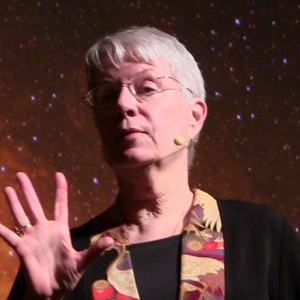
I’ve been going to Arecibo since 1978. Over the decades, we’ve built a lot of Arecibo-specific hardware, written a lot of software, and bent the telescope control system into modes it was never designed for.
Arecibo was an impressive feat of engineering, a scientific workhorse, and it never lost that aura of being slightly exotic, no matter how many times I visited there; the constant croaking of the coquis [a frog common to Puerto Rico], the perfumes of the tropical forest, the local Ron del Barrelito [a rum said to be the best on the island], the Gregorian dome with its unmistakable compressor cadence, the jogging track underneath the dish ringed with small orchids, Orion rising over the treetops as seen from the balcony of the VSQ [Visiting Scientists Quarters], before heading off to my midnight shift of Project Phoenix observations, and the absolutely best view on the island from atop the platform.
But most of all I remember the staff and the resident scientists who were very close knit, offered us superb technical support, and threw wonderful parties with lots of dancing. It is very sad to witness the passing of this scientific Queen. She withstood powerful hurricanes, but age appears to have gotten the upper hand.
Arecibo’s demise also led me to touch base with Greg Matloff (New York City College of Technology (NYCCT)), whose work on interstellar propulsion was what originally drew me to the field (his Starflight Handbook, written with Eugene Mallove, was a frequently consulted text and provoked the research that led to my Centauri Dreams book in 2004). We had discussed Arecibo’s role in planetary protection in many conversations. Said Matloff:

“The loss of Arecibo is heartbreaking. This observatory has contributed so much to the study of Earth’s upper atmosphere, Solar System and deep sky objects, and SETI. But its greatest significance today is its service as planetary radar. Much of what we know about Near Earth Asteroids that might someday impact the Earth is due to the imaging capabilities of this instrument. It is my hope that an upgraded Arecibo can be constructed at the same site to continue this work of Earth Defense.”
That’s a hope many of us share, and we will see what comes of it. I do notice in the National Science Foundation’s materials on the decommissioning that NSF intends “to restore operations at assets such as the Arecibo Observatory LIDAR facility — a valuable geospace research tool — as well as at the visitor center and offsite Culebra facility, which analyzes cloud cover and precipitation data. NSF would also seek to explore possibilities for expanding the educational capacities of the learning center.”
What may emerge following telescope decommissioning is worth pondering.

